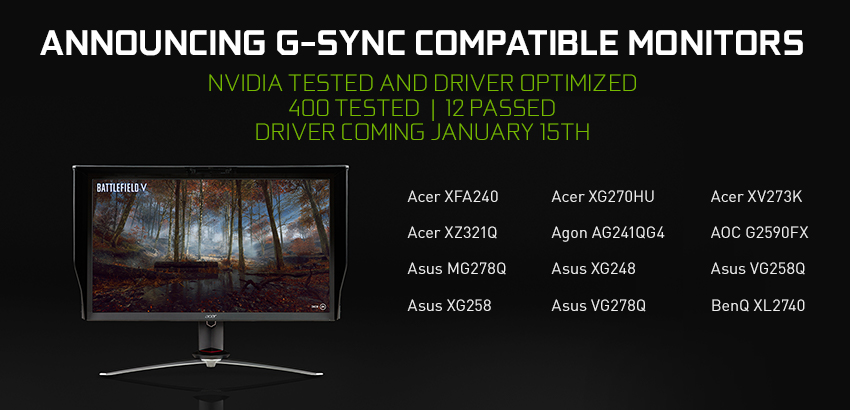News – Nvidia Announces Support for G-Sync VRR on Certain AMD FreeSync Monitors


Nvidia dropped a megaton during its CES 2019 live conference last night, announcing it will be expanding its G-Sync compatible ecosystem to include AMD FreeSync monitors. Team Green is adopting the VESA DisplayPort Adaptive-Sync protocol, massively widening the potential pool of compatible monitors.
The crucial part of this change is that G-Sync display typically commands a hefty price premium over FreeSync monitors but now certain AMD FreeSync monitors will be compatible with the G-Sync initiative.
Variable Refresh Rate (VRR) monitors allow for uncapped frame rates with no screen tearing or stuttering. Traditional V-Sync tech synchronises the GPU render rate to the monitor refresh rate, while VRR allows the monitor to alter its refresh rate in order to match the render rate of the GPU.
Nvidia’s being very particular with how it dishes out its G-Sync Compatible badges though. A grand total of 400 VRR monitors have been tested and just 12 have been handed the illustrious badge.

“There are hundreds of monitor models available capable of variable refresh rates (VRR) using the VESA DisplayPort Adaptive-Sync protocol,” writes Nvidia. “However, the VRR gaming experience can vary widely.
“To improve the experience for gamers, NVIDIA will test monitors. Those that pass our validation tests will be G-SYNC Compatible and enabled by default in the GeForce driver.”
Nvidia’s tests stipulate that the displays must show no indication of flickering, blank imaging, or artifacting whatsoever in order to earn the G-Sync badge. Screw up just once and it’s a fail, so Nvidia’s setting an imperiously high bar here which rules out some cheap and cheerful FreeSync monitors.
Don’t worry too much about Nvidia’s strict policing of VRR though. While monitors that have been validated as G-Sync compatible will have VRR support on Nvidia GPUs following a driver update, users to untested or failed monitors will be able to manually enable VRR too, albeit without official driver support.
This marks a massive sea change for Nvidia’s way of doing things. Up until now, G-Sync support required a proprietary G-Sync module that has a knock-on effect on monitor pricing. A move to a more open standard, while potentially adding more confusion for the customer, does make variable refresh rates and tear-free gaming a more affordable option. The change also means that Nvidia GeForce graphics cards are compatible with both G-Sync and FreeSync displays.
Nvidia’s official support for the VESA Adaptive-Sync standard begins rolling out on January 15th with a new driver update.





Leave a Reply